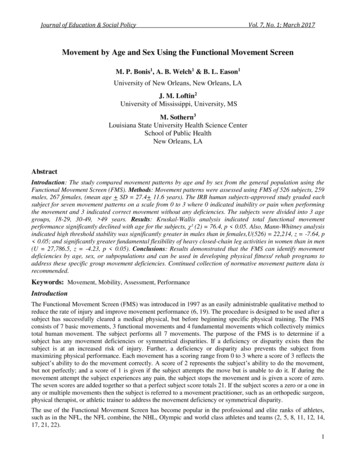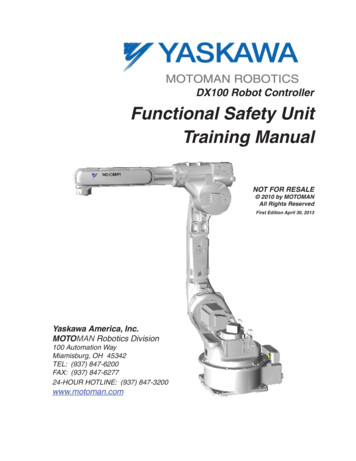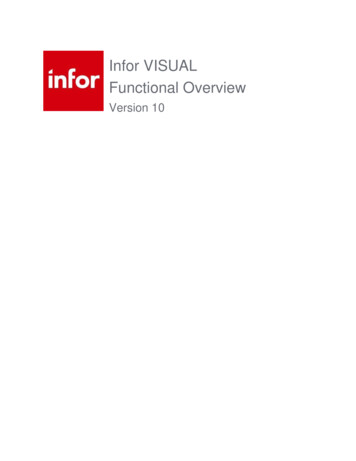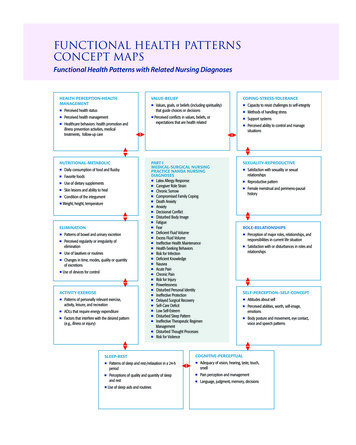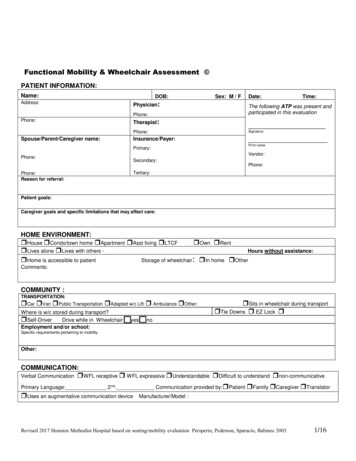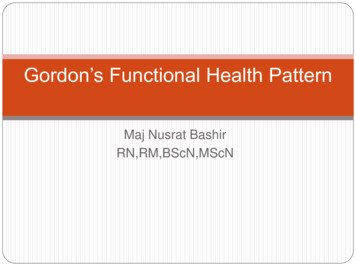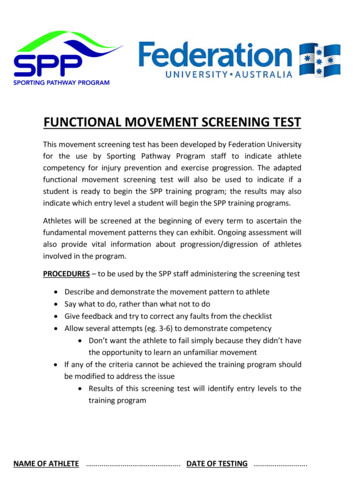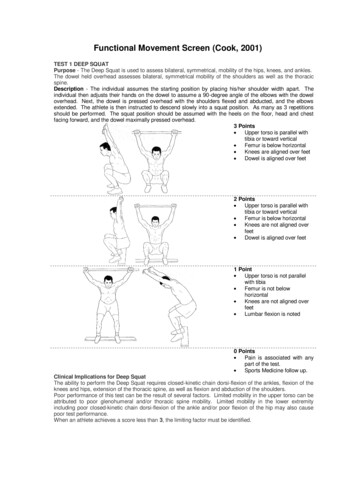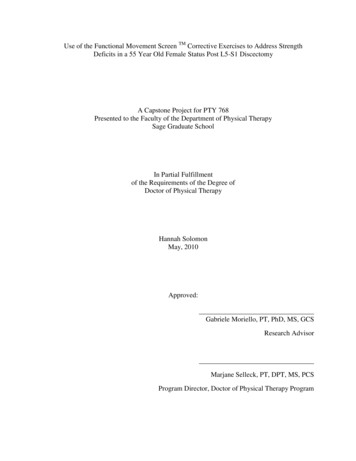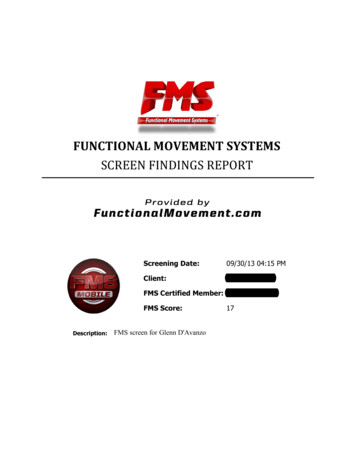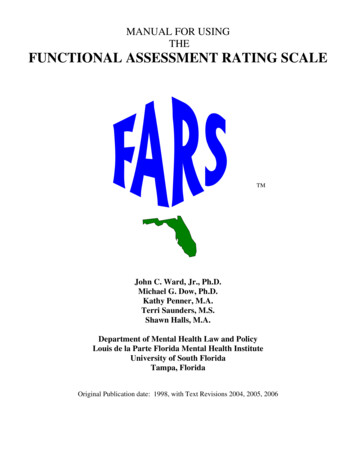
Transcription
MANUAL FOR USINGTHEFUNCTIONAL ASSESSMENT RATING SCALETMTMJohn C. Ward, Jr., Ph.D.Michael G. Dow, Ph.D.Kathy Penner, M.A.Terri Saunders, M.S.Shawn Halls, M.A.Department of Mental Health Law and PolicyLouis de la Parte Florida Mental Health InstituteUniversity of South FloridaTampa, FloridaOriginal Publication date: 1998, with Text Revisions 2004, 2005, 2006
Table of ContentsIntroduction .1Development of the Functional Assessment Rating Scale (FARS) .2Evaluation of Interrater Reliability and Validity of the FARS Domains 3Other State’s use of the FARS .5Most recent version of the Florida version of the FARS rating form . 6What is an Official FARS Rater Identification Number. . .8Instructions for using the “free” FARS Internet based Training and CertificationSystem . 13General Guidelines for Determining Severity Ratings for FARS Domains . .14Definitions and Behavioral Anchors for 18 FARS Functional Domains . 15Depression . . .16Anxiety. . .17Hyper Affect . . .18Thought Process . . . 19Cognitive Performance . . .20Medical/Physical. . .21Traumatic Stress. . .22Substance Use. . .23Interpersonal Relationships. . .24Family Relationships . . . 25Family Environment . . .26Socio-Legal. . .27Work or School. . 28ADL Functioning. . .29Ability to Care for Self. . .30Danger to Self. . .31Danger to Others. . .32Security/Management Needs . . .33Using FARS Domain Ratings to develop Individualized Treatment/Recovery Plans .34Factor Analysis of the 18 FARS Domains. .39Practice Training Vignette .40References .42
A MANUAL FOR USING THEFUNCTIONAL ASSESSMENT RATING SCALE (FARS)Florida Version – 1998-99, with text revisions - 2004INTRODUCTION:For a variety of economic, political, and humanitarian reasons, it is important to ensure the quality andeffectiveness of our full range of healthcare services. Prudent consumers generally seek this type ofinformation to select providers who meet standards of best practice for any number of these services.Traditionally, the term "consumer" referred to people who needed or received the healthcare service.Over the last decade, as the cost of health care continued to spiral upward, third party payers (e.g.,insurance companies) elected to become more prudent consumers themselves as they attended to theirroles in "purchasing" healthcare services. This evolved into the practice of managed care that placesgreater demands on providers to document quality and effectiveness of the process and the outcome oftheir interventions. This information has been used both to justify and control payments for service.Medical healthcare treatments, outcomes, and standards of care have been extensively evaluated andmay be more easily understood than behavioral healthcare services (e.g., mental health and substanceabuse services). In general, behavioral healthcare services have been examined less intensively since theyare often covered by public funds or only partially covered by limited benefit clauses in private insurancecontracts. As demands for improved accountability for use of these public funds (e.g. tax dollars)increases, state and federal agencies have adopted many of the practices of managed care. Standards ofcare and measures of behavioral healthcare outcomes are at varying stages of development. Many statesare now in the business of describing and establishing standards for delivery of publicly funded mentalhealth and substance abuse services.In Florida the “Government Performance and Accountability Act” was passed by the Legislature in 1994.This act established requirements that all State Agency budgets would be evaluated annually through aprocess of negotiated performance measures. The process, referred to as “Performance Based Planningand Budgeting” (PB)2, requires each general revenue funded state agency to establish, monitor, and reportannually to the legislature on three types of measures: 1) Inputs – which are the quantities of resources(e.g., dollars) used; 2) Outputs – which are the types of services delivered and the people served (e.g.,“units of case management services for persons with severe mental illness”); and 3) Outcomes – whichare the results of the services delivered (e.g., “improved functioning of a person with serious mentalillness”.In October of 1993, the District 7 Alcohol, Drug Abuse and Mental Health (ADM) Program Office of theFlorida Department of Children and Families – C&F (formerly the Department of Health andRehabilitative Services – HRS), entered into a collaborative agreement with the Louis de la Parte FloridaMental Health Institute (FMHI) at the University of South Florida (USF), in which FMHI would assist theDistrict 7 ADM program office in developing procedures to evaluate the effectiveness of their statefunded mental health and substance abuse treatment services for children and adults. That district wasone of the first areas of the state to pilot "Performance Contracting" as a way of negotiating andmonitoring expected outcomes and quality of care with community provider agencies (e.g., CMHCs). By1996, the Florida Department of Children and Families adopted the measures used in the “District 7Project” to evaluate all Adult Mental Health Performance Contracts throughout the state. Similarprocedures were implemented to evaluate state contracted substance abuse services for adults and mentalhealth and substance abuse services for children. Providers were also required to report outcomes (usingthe same measures) for people they served whose care was paid for by Medicaid funds. Thus, all peoplereceiving state supported behavioral healthcare services were evaluated (using the state approvedmeasures) at admission to the provider agency, six months or annually from admission if still in care,and at discharge from the provider agency. That information was used to inform decisions about service
effectiveness of agency contracts. Information reported as “Performance Contract” outcome measures byindividual provider agencies were also aggregated across the state to create “Performance Budgeting”reports to the Florida Legislature to monitor approximately 350 million dollars of the Florida Dept. ofChildren and Families annual budget.While normative standards may not yet exist, some "tools" have been developed and described in theresearch literature that examine the process and/or outcome of participation in a variety of behavioralhealthcare services. Several important “principles” guided the quest for valid and reliable measures. Inaddition to being sensitive to "cost," these principles included: 1) each consumers' quality of life shouldbe improved or restored as a result of participating in or receiving services; 2) consumers' levels offunctioning should be improved or restored as a result of participating in or receiving services; 3)consumers should be asked about their experience and/or satisfaction with their participation in orreception of services; and 4) outcome measures and reporting procedures should be “user friendly”,provide immediately available information that is helpful to the agencies who are delivering services(e.g. assist in treatment planning and quality assurance monitoring) and be able to be applied andinterpreted consistently.DEVELOPMENT OF THE FUNCTIONAL ASSESSMENT RATING SCALE (FARS):Project staff examined a number of levels of functioning scales and functional assessmentprocedures. One scale, the Colorado Client Assessment Record (CCAR) (Ellis, Wackwitz & Foster,1991) has an extensive history of use for monitoring changes in functioning in both mental health andsubstance abuse populations for children and adults. The CCAR has been used in Colorado for overfifteen years as a point of service assessment. It has also been employed as a research or service toolin several other states, including New York and Arizona. The CCAR can be completed by clinicianswith varying levels of training or experience and appeared to be adaptable without compromisingvalidity or reliability. Portions of the CCAR were revised to make it more useful to the needs of theDistrict 7 project. In discussions with representatives of the State of Colorado Department of HumanServices (Ellis, 1994), it was discovered that Colorado was also making revisions to the CCAR.Following exchanges of several drafts, similarities and differences evolved between the Colorado andFlorida versions. The Florida revisions to the CCAR resulted in the development of the FunctionalAssessment Rating Scale (FARS). The FARS was approved by the District 7 Project AdvisoryCouncil and was implemented in District 7 performance contracts in July of 1995. In October of1995, the FARS was adopted by DCF for statewide use along with specific “societal” outcomeindicators (e.g., income and days employed in previous month, days “in community” in previousmonth (i.e., not in jails, hospitals, psychiatric inpatient) as part of the Department of Children andFamilies Performance Based Planning and Budgeting (PB)2 legislative requirement to monitoroutcomes of the approximately 350 million dollars of DCF service contracts.Most behavioral healthcare evaluations are conducted as part of an admission interview, dischargeplanning or a case review. Although historical information is often necessary in understandinghuman behavior, in order to ensure that decisions made as a result of the assessment are sensitive tocurrent levels of cognitive and behavioral functioning, raters are asked to focus on a relatively briefperiod of time (i.e., the individual's functioning within the three weeks prior to the rating). As aclinical tool, the scales help identify and document an individual's level of cognitive and behavioral(social or role) functioning. This can then be used to develop and monitor progress on achievingshort or long-term goals on a comprehensive treatment or service plan. As a programmanagement or service monitoring tool, aggregated data from large groups of people can be usedto: 1) identify characteristics of those who use (e.g., benefit from) particular types of services; 2)2
develop risk adjusted norms (taking into consideration characteristics of consumers and/or systemsof care) to compare outcomes of similar programs or services; 3) evaluate continuity of caresystems to determine if needs are being adequately addressed by available resources and, 4) identifyprograms or services that can serve as benchmarks for effective models of care. It is important tonote that the FARS is a way of documenting and standardizing impressions from clinicalevaluations or mental status exams using cognitive, social and role functioning as its’ focus.Although it is not intended as a "structured interview" procedure, half of the clinicians whoparticipated in the implementation and evaluation of the FARS indicated they added questions totheir standard assessment in order to complete all areas of the scale. During that implementationevaluation, the clinicians indicated that it took between five to ten minutes to complete a FARS afterconducting a mental status or admission/discharge interview.Evaluation of Interrater Reliability and Validity of the FARS DomainsTables 1. shows the results of Inter rater reliability examination for the FARS.Table 1. Functional Assessment Rating Scale (FARS)Evaluation of Interrater Reliability(f ro m W a r d , D o w , S a u n d e rs , P e n n e r, & H a lls, 1 9 9 6 )(n 5 6 )0 .90 .80 .70 .60 .50 .40 .30 .20 .1GAFSecurityDngr OtherDngr Se lfSelfc areWk/SchLe galFam Envir3Fam RlnInpsn RlnSub UseTrm StressMedicalCog PerfThoughtHype rAnxietyDepress0
Table 2. shows the results of one type of validity study of the FARS (i.e., a comparison of thehighest admission domains with discharge ratings of those domains across several levels of care).Table 2. Comparison of Admission and Discharge FARS Problem SeverityRatingsFunctional Assessment Rating ScaleFunctional Assessment Rating ScaleCSU/Inpatient: Five Highest ScalesShort-term Residential Treatment: Five Highest Scales(Ward, Dow, Saunders, Penner, & Halls, 1996) FMHI/USF(Ward, Dow, Saunders, Penner, & Halls, 1996) FMHI/USFAdmission (n 310)Admission (n 52)Discharge (n 327)987654321DepressInpsn RlnFam RlnDngr otherDischarge (n 67)987654321SecurityDepressFam RlnFam EnvirDngr SelfSecurityFunctional Assessment Rating ScaleFunctional Assessment Rating ScaleCase Management: Five Highest ScalesIntensive Case Management: Five Highest Scales(Ward, Dow, Saunders, Penner, & Halls, 1996) FMHI/USF(Ward, Dow, Saunders, Penner, & Halls, 1996) ission (n 15)Cog PerfInpsn RlnADL FunctInpsn RlnAdmission (n 41)Cog PerADL FunctSelfcareDischarge (n 18)Discharge (n 12)Functional Assessment Rating ScaleFunctional Assessment Rating ScaleDay Treatment: Five Highest ScalesOutpatient: Five Highest Scales(Ward, Dow, Saunders, Penner, & Halls, 1996) FMHI/USF(Ward, Dow, Saunders, Penner, & Halls, 1996) FMHI/USF99887766554433221DepressCog PerfAdmission (n 310)Inpsn RlnWk/Sch1ADL FunctDepressDischarge (n 110)AnxietyAdmission (n 88)4Inpsn RlnFam RlnDischarge (n 16)Fam Envir
A description of FMHI's activities in the District 7 Project along with a discussion of thedevelopment and evaluation of the FARS and the project’s multi-dimensional consumer satisfactionmeasure (Behavioral Healthcare Rating of Satisfaction – BHRS) are included in two reports (Ward,Dow, Saunders, Penner, Halls & Burbine, 1995, and Dow, Ward, Saunders, Penner, Halls, Thornton,Carroccio, Salmon and Sachs- Ericsson, 1996).The FARS and the children’s version, referred to as the Children’s Functional Assessment RatingScale – CFARS, have been implemented in Florida and other states or areas to evaluate or trackeffectiveness of behavioral health services. Currently, contracted provider agencies send FARS andCFARS data to the State DCF Office using the OneFamily secure internet reporting system. The JointCommission on Accreditation of Healthcare Organizations also approved both measures for use byaccredited agencies to report ORYX outcomes to the JCAHO. The FARS and CFARS scales werealso available in several versions of the Management Information Systems (MIS) software developedby CMHC Systems.OTHER STATE’S USE OF THE FARS and CFARS:In July of 1998, with training assistance from the Florida Mental Health Institute, the WyomingDivision of Behavioral Health implemented the FARS and CFARS (which was also in use statewidein Florida to monitor outcomes of children’s mental health service contracts in Wyoming.Within a couple of years of adoption of the FARS and CFARS in Florida and Wyoming, NewMexico and Illinois also completed statewide implementation of the FARS and CFARS to monitorservice outcomes. Both scales are also in use in several other states or countries at agency or smallregional levels, including use of the CFARS by Malta to monitor services for children receiving statesupported residential care.The remaining sections of this manual will show you an example of the most recent version of theFARS that is in use in Florida, along with sections that explain procedures for completing each areaof the FARS, some important guidelines that will help you determine the most accurate problemseverity ratings for each functional domain, how to use the FARS domain ratings to developindividualized treatment/service/recovery plans, descriptions of rating “anchors” for each of the 18domains, and a brief “case” example vignette that you can use for practice ratings before you take thefree web-based on-line training and certification (see page 12 in this manual for detailed instructionsabout how to register and take this free training on the internet).5
Functional Assessment Rating Scale – Florida VersionName of person being evaluated (Optional - required only if needed byyour agency or a paper copy of this form is retained in clinical record, pleaseprint):(last) (first) (mi)Gender:(Required)ddClient ID#(Optional):yyyy Male/ /Provider Agency Tax ID (Required):Date of Birth (Required): / /mmSSN of person being Evaluated: (Required) :Sub-Contractor Tax ID(if FARS done by Sub):Date of Assessment (Required): / / FemalemmddyyyyPurpose of EvaluationDCF Outcomes Report(Required) mark only one Program Evaluation(Optional)Admission to ProviderFARS Rater’s Notes (Optional):Admission to Program Post Admission Evaluation(e.g., six months, annual, etc.) 6 Months After Admission toProgram Discharge from ProviderAnnually After Admission toProgram Planned Discharge from, orTransfer to another Program within agency Administrative/ImmediateDischarge Administrative/Immediate Discharge None of the above None of the aboveDSM-IV Code for Primary Diagnosis (Optional):.DSM-IV Code for Secondary Diagnosis (Optional): .Substance Abuse History(Required)This person indicates they have abuseddrugs or alcohol within past six months:YesNoModified Global Assessment of FunctioningRevised (MGAF-R) Rating(Required instead of FARS for People receiving“Medication Only” Services)FARS Rater InformationEducational Category of FARS Rater(Please refer to DCF Pamphlet 155-2 for complete descriptions of each category)Mark Only One Category:(01) Non-degree tech.(03) Unlicensed Bachelor’s degree(04) UnlicensedMaster’s degree(06) Ph.D., Ed.D. or LicensedPsychologist(07) M.D., D.O. LicensedBoard Certified Psychiatrist(02) AA degree tech.(05) LicensedCSW/MFT/MHC/AARNP/PANine Digit Certified FARS Rater ID Number of person completing the Problem SeverityRatings on the back of this form (Required):(note: free training and certification available at http://outcomes.fmhi.usf.edu)Signature of Rater: (Optional - required only if needed by your agency or a paper copy of this form isretained in clinical record)6
FARS Problem Severity RatingsUse the following 1 to 9 scale to rate the individual’s current (within last 3 weeks) problem severity for each functional domain listed below. Place your ratingnumber on the line to the right of the Domain name. Also, using the list below each domain rating, place an “X” mark next to the adjectives or phrases thatdescribe symptoms or assets. (Refer to FARS User’s Manual for specific examples of use of this scale available at http://outcomes.fmhi.usf.edu)1NoPro
A MANUAL FOR USING THE FUNCTIONAL ASSESSMENT RATING SCALE (FARS) Florida Version – 1998-99, with text revisions - 2004 INTRODUCTION: For a variety of economic, political, and humanitarian reasons, it is important to ensure the quality and effectiveness of our full range of healthcare services. Prudent consumers generally see
